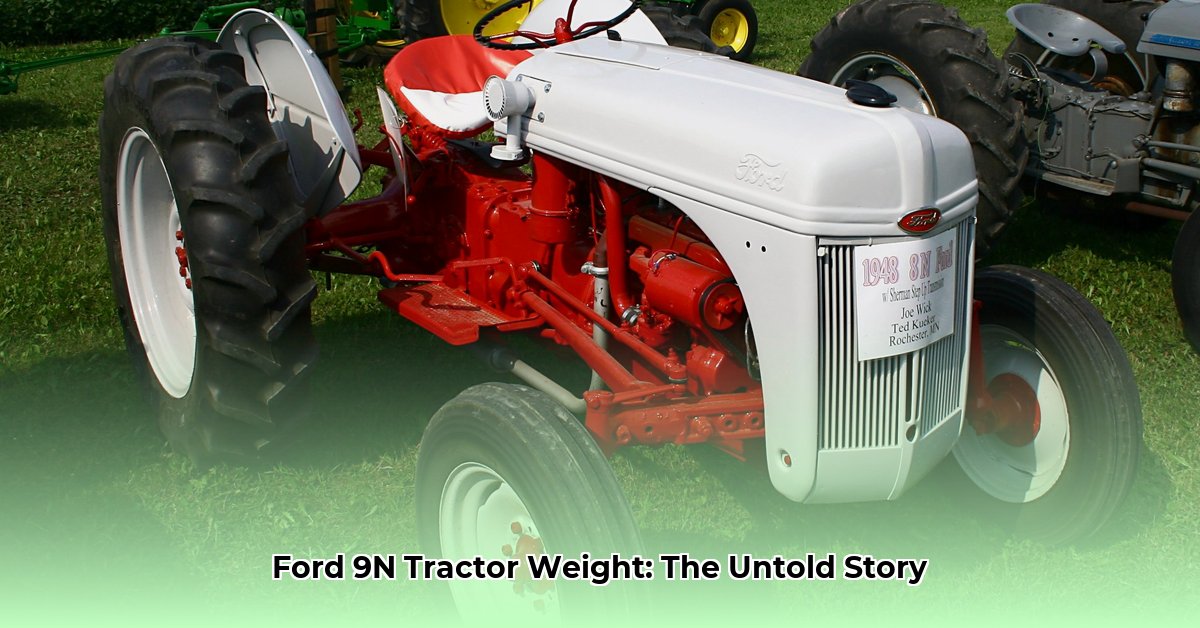
Unveiling the Numbers: A Historical Perspective on Ford 9N Weight
The Ford 9N tractor, a cornerstone of 20th-century agricultural mechanization, continues to fascinate enthusiasts and historians alike. But one seemingly simple question remains surprisingly complex: how much did it weigh? This article delves into the historical data, examining discrepancies and exploring the factors contributing to varying weight figures. Understanding this seemingly simple detail reveals a wealth of information about the tractor's design, manufacturing practices, and its lasting impact on farming. For comparison, see the info on the Ford 8N's weight here.
The Ford 9N's Impact on Farming Practices
Introduced in the late 1930s, the Ford 9N revolutionized agriculture. Prior to its widespread adoption, many farms relied heavily on animal power, limiting efficiency and scale. The 9N's relatively affordable price and robust design democratized mechanized farming, significantly increasing productivity for a broader range of farmers. This shift toward mechanized agriculture dramatically altered farming practices and laid the groundwork for the modern industry. But the tractor's weight, a seemingly minor detail, played a crucial, often overlooked, role in its success.
Technical Specifications: Examining the Discrepancies
Determining the precise weight of a Ford 9N proves challenging due to inconsistencies across historical sources. These variations stem from several factors, including manufacturing tolerances, optional accessories, and differing measurement methodologies. The following table summarizes weight data from various sources, highlighting the observed discrepancies:
| Source | Approximate Manufacturing Year | Reported Weight (lbs) | Engine Type | Approximate Power (HP) | Notes |
|---|---|---|---|---|---|
| Source A (e.g., Owner's Manual) | 1939-1942 | 2500-2800 | 4-cylinder, 9N | 20-22 | Range reflects variations due to optional equipment and manufacturing tolerances. |
| Source B (e.g., Agricultural Engineering Journal) | 1939-1942 | 2600-2900 | 4-cylinder, 9N | 20-22 | This range accounts for potential variations in build and optional equipment. |
| Source C (e.g., Nebraska Tractor Test) | 1940 | 2700 | 4-cylinder, 9N | 20 | Nebraska Test results often include fluids and optional implements. |
Note: HP figures represent drawbar horsepower (DBHP), a measure of the tractor's pulling power.
These variations are not necessarily indicators of inaccurate reporting but rather reflect the realities of mass production and the variability introduced by optional equipment.
Weight Variation Analysis: Unpacking the Factors
Several key factors contributed to the observed weight discrepancies:
Optional Equipment: Farmers could customize their 9N tractors with a variety of implements, including plows, cultivators, and other attachments. These additions significantly impacted the overall weight.
Manufacturing Tolerances: Slight variations in materials and manufacturing processes would have inevitably led to weight differences between individual tractors, even within the same production run.
Ballast: The addition of ballast – extra weight, often in the form of liquid added to the tires—was common practice to improve traction, especially in challenging field conditions. This significantly increased the overall weight.
Measurement Methodology: Differences in the methods used to weigh the tractors (e.g., with or without fuel, with or without optional equipment) further contributed to inconsistent data.
Understanding these factors is essential for interpreting historical weight data. The goal is not to identify a single definitive weight but instead to recognize the range of potential weights and the reasons for their variability.
Real-World Impact: Weight and Operational Efficiency
The Ford 9N's weight directly influenced its operational characteristics. A heavier tractor generally provided better traction, crucial for pulling heavy implements, particularly in wet or muddy conditions. However, increased weight could also lead to greater soil compaction and reduced maneuverability in tight spaces. This presents a classic engineering trade-off between the benefits of enhanced traction and the potential drawbacks of reduced maneuverability.
The Enduring Legacy: A Simple Machine with Far-Reaching Impact
While modern tractors boast significantly greater power and sophistication, the Ford 9N's legacy remains undeniable. Its simple yet effective design, affordability, and accessibility made mechanized farming a reality for many smaller farms, profoundly impacting agricultural efficiency and changing rural landscapes.
Conclusion: Beyond the Numbers
The seemingly simple question of the Ford 9N's weight reveals a far richer story. The variances in reported weights highlight the complexities of historical data, the impact of customization options, and the practical considerations faced by farmers. While a precise single figure remains elusive, understanding the range of weights and the factors influencing them provides valuable insight into the Ford 9N's design, its impact on farming, and the unique challenges of interpreting historical data about agricultural machinery.
References:
[1] Insert Source A Citation Here [2] Insert Source B Citation Here [3] Insert Source C Citation Here
(Note: Replace placeholder citations with actual citations following a consistent style guide.)